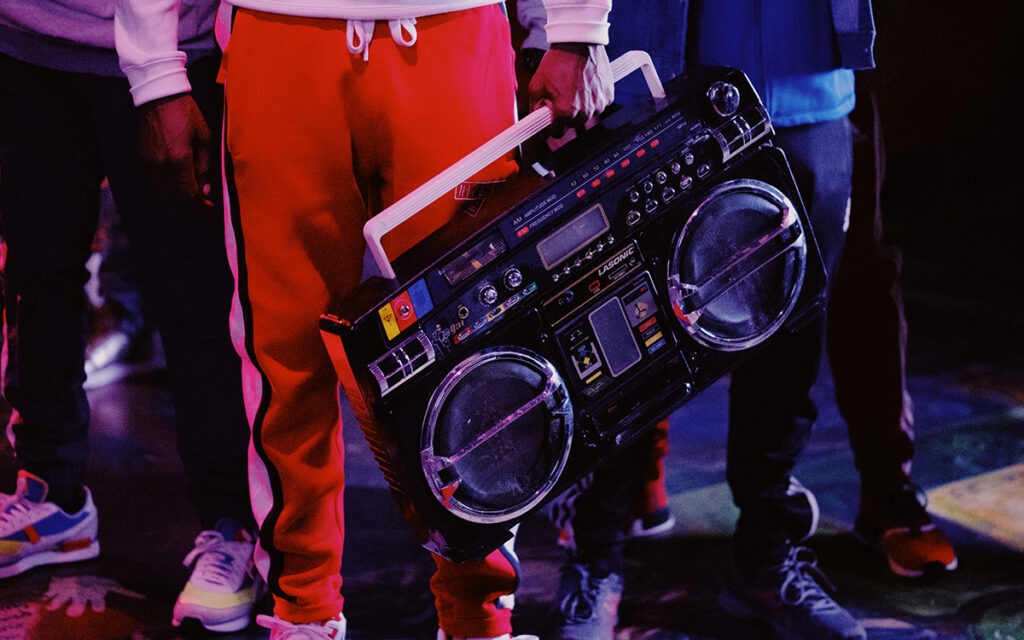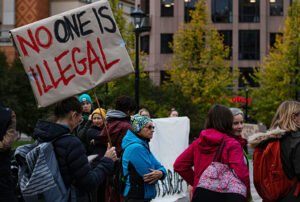
Hip hop—the music and its culture—turns 50 this year. The artists behind this popular genre are also at the forefront of philanthropic giving today. That’s because hip-hop culture embraces the principle of “sankofa,” valuing the importance of going back to a community after becoming successful and bringing others along. Hip hop’s practice of sankofa is transforming philanthropy, paving the way for future innovation in the sector through funding opportunities that bring underserved communities into the fold.
To those who aren’t down with the culture, hip-hop philanthropy might seem like a new development, but it isn’t. Artists who embrace hip hop as a culture and lifestyle are street poets who shed light on the glories and grim realities of living in undercapitalized and systemically neglected communities. At the culture’s heart are several core themes: community pride, racial justice, neighborhood revitalization, and investing in homegrown talent and solutions.
So while hip hop was built on five core elements—MCing (oral), DJing (aural), Breakdancing (physical), Graffiti (visual), and Knowledge (mental)—it has an overlooked sixth element of Philanthropy (community). This element connects hip hop’s contributions to the social sector.
The Foundation: Sankofa
To understand how hip-hop artists are transforming the sector, it’s important to know that hip-hop culture’s sixth element of philanthropy is grounded in sankofa, an Akan word that means, “it is not taboo to fetch what is at risk of being left behind.” The cultural value of sankofa is why hip-hop artists who understand their communities’ assets and needs often return to reinvest in them. One example of how sankofa shows up in hip-hop music is through sampling, a technique that leverages the melodic, dynamic, and harmonic elements of other songs to create a new masterpiece. In embracing sankofa, hip hop makes itself synonymous with Black music by adopting the sounds and culture of funk, jazz, blues, and traditional African influences.
In the genre’s earliest formations, hip hop’s philanthropic pioneers were also masterful at grantmaking that moved power and resources into the hands of community members. They invested resources directly in people rather than organizations or institutions. This form of grantmaking—now called “direct philanthropy”—encourages investors to understand community assets and establish investing priorities to address each community’s unique needs.
Take Grandmaster Caz of the Cold Crush Brothers: he incentivized students in the Bronx to earn better grades in exchange for a fresh pair of kicks. He even built a recording studio in a Bronx elementary school to expose youth to the $2-trillion creative economy. Hip-hop purists credit Grandmaster Caz with writing “Rapper’s Delight,” the Sugarhill Gang hit song that introduced hip hop to mainstream culture.
Queen Latifah, one of hip hop’s most powerful creators, has often spoken and rapped about direct philanthropic practices. In the song, “Queen and King Creation,” she says,
Teach the youth, feed the needy
Confident descendant of Queen Nefertiti
The mother of civilization will rise
Like the cream and still build the strong foundation.
Latifah lived the principles of these lyrics by starting the Lancelot H. Owens Scholarship Foundation in 1992 to award college scholarships to economically challenged high school students in underprivileged neighborhoods throughout New York City’s tri-state area. By promoting community uplift and economic opportunity, early innovators like Latifah redefined traditional philanthropic practices, paving the way for future hip-hop practitioners to build on their work.
Like Latifah and Grandmaster Caz before them, today’s hip-hop artists leverage their success to funnel millions of dollars into communities domestically and globally to combat racial and economic inequities. Among the foundations such artists have started are 50 Cent’s G-Unity Foundation, which provides grants to nonprofit organizations improving the quality of life of low-income and underserved communities across the US, A$AP Rocky’s A$AP Foundation, which addresses substance abuse, and Rihanna’s Clara Lionel Foundation, which supports groundbreaking climate resilience and climate justice projects in the US and Caribbean using a trust-based, intersectional approach to support community-led change.
Venture Philanthropy and Group Economics
While philanthropic giving is now a common practice for many artists, a few are influencing mainstream philanthropy. Airmiess Asghedom—also known as Nipsey Hussle—was on the cutting edge of innovative venture philanthropic practices, an approach that embraces venture capital, or VC, investment principles and disruptive social ventures, uplifts cutting-edge leaders, and co-invests alongside others. Nipsey died tragically from gun violence in 2019 but left a legacy of innovative philanthropic practices that serve as a model for national foundations and VC firms.
Hip-hop and gang culture have a symbiotic and complicated relationship. Nipsey identified as a Rollin 60’s Crip. As the lyrics to the song, “Blue Laces,” make clear, he was keenly aware of the systemic challenges, community poverty, and lack of opportunity that led him to join his set.
Third generation South Central gang bangers
That lived long enough to see it changing
Think it’s time we make arrangements
Finally wiggle out they mazes, find me out in different places
“I’m the Spook [Who Sat] By the Door,” this the infiltration, double back, dressed in blue laces.
Sign up for our free newsletters
Subscribe to NPQ's newsletters to have our top stories delivered directly to your inbox.
By signing up, you agree to our privacy policy and terms of use, and to receive messages from NPQ and our partners.
Before he was known as Nipsey, an 11-year-old Airmiess approached a well-known local Crip and asked the man why he gang banged. The man replied that he was born into gangs and did not have a choice. To this, Airmiess responded that when he grew up, he would take care of the community, ensuring that the current and next generation of youth have choices for a self-determined life. In this, Nipsey was influenced by proponents of Black group economics who argue that, while reparatory justice is a debt owed to Black Americans, it cannot be the only solution to closing the wealth gap; economic improvement must start with group economics.
To this end, Nipsey partnered with a real-estate investor, David Gross, to create Vector 90, a coworking space, cultural hub, and business incubator for Black economic opportunity in Los Angeles’s Crenshaw District. In a neighborhood where, according to the Opportunity Atlas, the average annual household income for Black families is $22,000, and only 15 percent of Black residents have a college degree, Vector 90 brings VC and philanthropic investments to establish more robust STEM workforce pathways and career-connected learning opportunities for youth and adult learners.
Nipsey deployed integrated capital into historically disinvested communities—and in doing so, he brought together the traditional venture and philanthropic sectors. His influence on Chris Lyons, a tech VC executive at Andreessen Horowitz, led to Lyons co-founding the firm’s Cultural Leadership Fund in 2018 to address gaps in access and equity for African Americans in technology. CLF has two key goals: more Black dollars on the capitalization tables of the world’s best companies and Black talent embedded in technology companies at the earliest stages. The fund has raised over $60 million from its all-Black limited partners—among them Sean “Diddy” Combs, Anderson.Paak, Pharrell Williams, and Chance the Rapper—and is one of the first and largest all-Black funds. Today, it connects Black cultural leaders to investment from innovative companies in crypto, biotech, fintech, and other industries.
This is important because the assets of Black-led nonprofits and companies are significantly smaller than those of their White counterparts. In 2022, only 4 percent of philanthropic dollars went to Black-led organizations. Black start-ups experience more significant disparities; Black founders raised an estimated $2.2 billion out of $215.9 billion in VC allocated last year—just one percent of all VC funds.
To obtain funding, Black founders must be connected to Black leaders with access to capital; however, according to the Council of Foundations, Black, Indigenous, and people of color account for just 31 percent of foundation professionals and only 14 percent of foundation CEOs. Funds like CLF practice group economics by building a collective of Black investors, increasing Black founders’ opportunities to raise more dollars to sustain and grow their work.
Funder Collaborations for Policy Change
Hip-hop artists are at the forefront of establishing funder collaborations to promote collective giving—an emerging trend that extends the principles of Black group economics into today’s sector. Funders are increasingly pooling their resources into collaborative vehicles to tackle systemic challenges.
Jay-Z, for example, is a well-established philanthropist and investor, who partners with others for policy change. In 2019, he partnered with rapper Meek Mill, Michael Rubin, and other high-profile philanthropists to launch the REFORM Alliance. The alliance aims to transform unjust probation and parole practices by changing laws, systems, and culture to create pathways to work and wellbeing. Since it started, the REFORM Alliance has achieved substantial policy wins, become a blueprint for collective action, and significantly moved the needle on prison reform legislation.
Although hip-hop artists and culture bearers have long practiced philanthropy in ways that have gone unnoticed, their practices are changing traditional philanthropic spaces.
For instance, in 2022, the REFORM Alliance established a bipartisan coalition in Florida to pass SB752, a bill that will improve outcomes and success rates for people on probation. Florida’s Black residents represent 47 percent of the state’s prison population but only 17 percent of the state’s general population. Florida also has the fifth-largest probation population in the United States, spending almost $212 million annually on its supervision system. SB752 will shorten probation terms and reduce the overall size of Florida’s probation system, impacting over 150,000 people over the next five years. Through such coalition work, field building, and funder collaboration, the alliance has also achieved policy wins in California, Michigan, Georgia, New York, Mississippi, and other states.
Investing in Everyday Leaders and Solutions
Leaders who embrace hip-hop culture are shifting how institutional and traditional philanthropic and investment vehicles operate and are structured. Although hip-hop artists and culture bearers have long practiced philanthropy in ways that have gone unnoticed, their practices are changing traditional philanthropic spaces. An emerging group of philanthropic and venture leaders who find inspiration from the latest Rapsody or Big K.R.I.T. albums are now sitting at the decision-making table.
Jason Norman is one such leader. Norman combines the spirit of hip hop and philanthropy in his work as co-founder and partner at Concrete Rose Capital, a venture-capital firm that built its name and philosophy from Tupac’s poem, “The Rose That Grew from Concrete”:
Did you hear about the rose that grew from a crack in the concrete?
Proving nature’s law is wrong it learned to walk without having feet.
Funny it seems, but by keeping its dreams, it learned to breathe fresh air.
Long live the rose that grew from concrete when no one else ever cared.
At a time when leaders of color are calling for philanthropy to give assets back to communities toward repair, hip-hop philanthropy has something to contribute.
A firm built to fund founders of color from communities that have been historically divested from, Concrete Rose invests strategic capital into ventures led by those closest to the solutions. The firm also established the Concrete Rose Community Fund to drive resources to the most effective nonprofit initiatives, closing opportunity gaps for underrepresented talent in America.
At a time when leaders of color are calling for philanthropy to give assets back to communities toward repair, hip-hop philanthropy has something to contribute. As Aria Florant and Venneikia Williams note for NPQ, traditional philanthropy is an engine that runs on hoarded wealth. They argue that “Many—if not most—foundation benefactors earned their fortunes through the exploitation of people, land, and resources. Once accumulated, this wealth is maintained—often in perpetuity.”
In contrast, hip hop and the leaders who value its culture are embracing sankofa, sharing power, and practicing group economics. Their work points to a model for effective philanthropy, community restoration, and ultimately, a liberated future.









